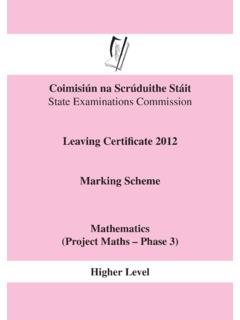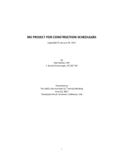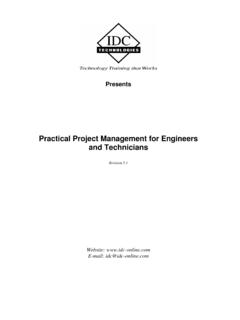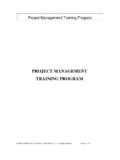Transcription of MATHEMATICS - mathsdojo.ie
1 Coimisi n na Scr duithe St itState Examinations CommissionLEAVING CERTIFICATE 2011 MARKING SCHEMEMATHEMATICS( project MATHS)ORDINARY LEVEL [3] Contents Page Introduction .. 4 Model Solutions Paper 1 .. 5 Marking Scheme Paper 1, Section A and Section B .. 18 Structure of the marking scheme .. 18 Summary of mark allocations and scales to be applied .. 20 Detailed marking notes .. 21 Marking scheme Paper 1, Section C .. 26 General Guidelines for Examiners Paper 1, Section C .. 26 Question 7 .. 27 Question 8 .. 32 Question 9 .. 37 Model Solutions Paper 2 .. 43 Marking Scheme Paper 2 .. 60 Structure of the marking scheme .. 60 Summary of mark allocations and scales to be applied .. 62 Detailed marking notes .. 63 Marcanna Breise as ucht Freagairt tr Ghaeilge .. 73 [4] Introduction The Ordinary Level MATHEMATICS examination for candidates in the 24 initial schools for project Maths shared some content with the examination for all other candidates.
2 The marking scheme used for the shared content was identical for the two groups. This document contains the complete marking scheme for both papers for the candidates in the 24 schools. Readers should note that, as with all marking schemes used in the state examinations, the detail required in any answer is determined by the context and the manner in which the question is asked, and by the number of marks assigned to the question or part. Requirements and mark allocations may vary from year to year. [5] 2011. M227 Coimisi n na Scr duithe St it State Examinations Commission Leaving Certificate Examination, 2011 MATHEMATICS ( project Maths Phase 2) Paper 1 Ordinary Level Friday 10 June Afternoon 2:30 4:30 300 marks Model Solutions Paper 1 Note: the model solutions for each question are not intended to be exhaustive there may be other correct solutions.
3 Any examiner unsure of the validity of the approach adopted by a particular candidate to a particular question should contact his/her advising examiner. [6] Instructions There are three sections in this examination paper: Section A Concepts and Skills 100 marks 4 questions Section B Contexts and Applications 100 marks 2 questions Section C Functions and Calculus (old syllabus) 100 marks 3 questions Answer questions as follows: In Section A, answer all four questions In Section B, answer both Question 5 and Question 6 In Section C, answer any two of the three questions. Write your answers in the spaces provided in this booklet. There is space for extra work at the back of the booklet. You may also ask the superintendent for more paper. Label any extra work clearly with the question number and part. The superintendent will give you a copy of the booklet of Formulae and Tables.
4 You must return it at the end of the examination. You are not allowed to bring your own copy into the examination. Marks will be lost if all necessary work is not clearly shown. Answers should include the appropriate units of measurement, where relevant. Answers should be given in simplest form, where relevant. Write the make and model of your calculator(s) here: [7] Section A Concepts and Skills 100 marks Answer all four questions from this section. Question 1 (25 marks) (a) Explain what a prime number is. A natural number that has 2 factors only (b) Express 2652 as a product of prime numbers. 2 2652 2 1326 3 663 13 221 17 17 1 2652 = 1713322 (c) The number 6121 is a prime number.
5 Using your calculator, or otherwise, express its value, correct to two significant figures, in the form 10na , where 110a < and Nn . 182 3 10 (d) Use your answer to part (c) to state how many digits there are in the exact value of 6121 . 19 digits [8] Question 2 (25 marks) (a) A certain deposit account will earn 3% interest in the first year and 6% interest in the second year. The interest is added to the account at the end of each year. If a person invests 20 000 in this account, how much will they have in the account at the end of the two years? Year 1 Principal = 20,000 3 % Interest = 600 Year 2 Principal = 20,600 6 % Interest = 1,236 Amount at end of 2 years = 21,836 OR 20000 1 03 1 06 21,836 = (b) Show that, to the nearest euro, the same amount of interest is earned by investing the money for two years in an account that pays compound interest at 4 49% (AER).
6 TiPF)1(+= P = 20,000 i = 0 0449 t = 2 Method 1 Method 2 22 20000(1 0 0449) 20000(1 0449) 21, 836 32FF=+== Rounded to the nearest euro = 21,836 Interest = 1,836 Conclusion: Same amount of interest earned P1 = 20000 4 49% = 898 P2 = 20898 4 49% = 938 32 Total Interest = 1836 32 Rounded to nearest euro = 1,836 [9] Question 3 (25 marks) The terms in an arithmetic sequence are given by the formula 38 4nTn= , for n = 1, 2, 3, 4, .. (a) Write out the first three terms in the sequence. 26)3(43830)2(43834)1(438321= == == =TTT First 3 three terms are 34, 30, 26 (b) What is the first negative term in the sequence? 0<nT 0438< n n4 < -38 n4 > 38 n > T10 is the first negative term T10 = 38 4(10) = -2 (c) Find the sum of the first 15 terms of the sequence.
7 {}dnanSn)1(22 += n = 15 a = 34 d = -4 {})4)(115()34(221515 +=S = {12} S15 = 90 (d) Find the value of n for which the sum of the first n terms of the sequence is 0. {}{}047220)4)(1()34(220= = + =nnnnSn 223620180(18)00 18 18nnnnnnnnn = = = = = [10] Question 4 (25 marks) (a) Solve the simultaneous equations: ++=++= 62 322fgfg+= += 62 3424fgfg+= = 2112= =ff 32216 =+ g 362323 = = =+ggg (b) Solve the following inequality, and show the solution set on the number line below. 319485x xxxx (Assuming x R) -5 -4 -3 -2-1012345 6 3 5 [11] Section B Contexts and Applications 100 marks Answer both Question 5 and Question 6. Question 5 (50 marks) z is the complex number 1i+, where 21i=.
8 (a) (i) Find 2z and 3z. iziiiiz221)1)(1(222= ++=++= iziiiizzz2222)1(23223+ = +=+== (ii) Verify that 44z= . 4)1(44)2)(2(24224 = === =iiizzzz (iii) Show 234,, and zz zz on the Argand diagram. (iv) Make one observation about the pattern of points on the diagram. Getting progressively further from the origin Or Moving in an anticlockwise direction -4-3-2-11 2 34-4 -3 -2 -1 1 2 3 4 Im Rez4 z3 z2 z [12] (b) Using the value of 4z, or otherwise, find the values of 8z, 12z and 16z, and insert their values in the table below. ()()()()()256464416)4(44416334122248= == = === ==zzzzzz 4z 8z 12z 16z 4 16 - 64 256 (c) Based on the pattern of values in part (b), or otherwise, state whether 40z is positive or negative. Explain how you got your answer. z40 is positive as all powers that are multiples of 8 are positive.
9 Every second term in the table is positive. z40 is the tenth term in the table so it will be positive. (d) Write 40z as a power of 2. Method 1 Method 2 ()()()201021010104402 2 4 )4( === ==zz ()201040210485764== =z [13] (e) Find 41z. ()iizzz10485761048576 12 204041+=+== (f) On an Argand diagram, how far from the origin is41z? Method 1 Method 2 ()()41202220204040404120 52(1 ) 22 22 2(2 ) 2 2zi=+=+=+=== ()22220414141===zz [14] Question 6 (50 marks) At a certain point during the flight of a space shuttle, the booster rockets separate from the shuttle and fall back to earth. The altitude of these booster rockets (their height above sea level) is given by the following formula: 2714510200htt=+ where h is the altitude in kilometres, and t is the time in seconds after separation from the shuttle.
10 (a) Complete the table below, showing the altitude of the rockets at the indicated times. time in seconds, t 0 20 40 60 80 100 altitude in km, h time in seconds, t 0 20 40 60 80 100 altitude in km, h 45 57 65 69 69 65 2714510200htt=+ Substitute t = 0, 20, 40, 60, 80 and 100 into the above formula. This gives h = 45, 57, 65, 69, 69 and 65 (b) On the opposite page, draw a graph of the altitude of the rockets for the first 100 seconds after separation from the shuttle. (c) Use your graph to estimate the greatest altitude reached by the rockets.














